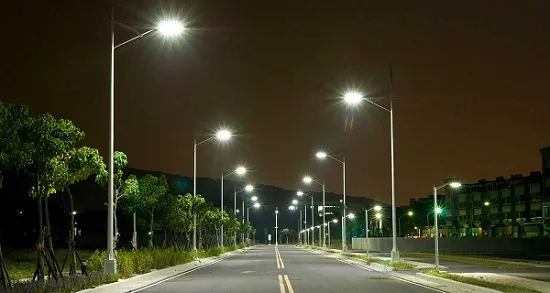Blog
Illuminating Urban Landscapes: The Evolution and Importance of Commercial Street Lights

In the ever-evolving tapestry of urban development, commercial street lights stand as silent sentinels, casting their gentle glow over cityscapes and suburban avenues alike. These unassuming fixtures, often taken for granted, play a pivotal role in enhancing safety, aesthetics, and economic activity within urban environments. This article explores the evolution and importance of commercial street lights, shedding light on their multifaceted impact on modern society.
A Historical Journey: From Gas Lamps to LED Brilliance
The history of commercial street lights dates back to ancient civilizations, where oil lamps were employed to illuminate pathways. However, it wasn’t until the 18th and 19th Street light in village that advancements in technology led to the widespread use of gas lamps, revolutionizing urban nighttime landscapes. The soft, flickering light of gas lamps not only facilitated safer navigation but also added a sense of enchantment to city streets.
The late 19th century witnessed the transition from gas to electric street lights, marking a significant milestone in urban illumination. Thomas Edison’s incandescent bulb, patented in 1879, became a key player in this transition. Over the decades, improvements in bulb design, materials, and energy efficiency paved the way for High-Intensity Discharge (HID) lamps like metal halide and high-pressure sodium, which dominated street lighting for much of the 20th century.
The Dawn of LED Lighting: Efficiency and Customization
The 21st century brought about a revolutionary change in commercial street lighting with the road lighting adoption of Light Emitting Diodes (LEDs). LEDs offered remarkable energy efficiency, longevity, and a wide range of color temperatures. This technological leap allowed city planners and architects to not only illuminate streets but also create specific moods and atmospheres.
LEDs enabled the customization of lighting designs, contributing to the aesthetic appeal of urban areas. They also offered intelligent control options, allowing for dimming, remote monitoring, and even adaptive lighting that adjusts based on traffic road lighting
conditions or pedestrian movement. This level of control not only improved energy efficiency but also reduced light pollution, a growing concern in urban planning.
The Multifaceted Importance of Commercial Street Lights
The significance of commercial street lights goes far beyond mere illumination. Here are some of their critical roles:
- Safety and Security: Well-lit streets deter crime and enhance pedestrian safety by providing clear visibility. Adequate lighting reduces accidents and makes public spaces feel safer, encouraging people to utilize them even during nighttime hours.
- Economic Impact: Proper lighting can stimulate economic activity by extending business hours for shops and restaurants, creating a vibrant nightlife, and attracting more visitors to commercial areas.
- Traffic Management: Street lights aid traffic flow by ensuring clear visibility of road signs, intersections, and pedestrian crossings. They contribute to smoother vehicular movement, reducing congestion and potential accidents.
- Cultural Identity and Aesthetics: Thoughtfully designed street lighting can enhance the character and identity of a city. Historic districts can maintain their charm with traditional-style lamps, while modern areas can make a statement with sleek, contemporary fixtures.
- Environmental Considerations: LED street lights have significantly reduced energy consumption and lower maintenance requirements compared to traditional lighting technologies. This translates to reduced carbon emissions and lower operating costs for municipalities.
- Community Engagement: Festive lighting for holidays and special occasions fosters a sense of community and shared celebration, drawing residents and visitors together.
Looking Ahead: Smart and Sustainable Lighting Solutions
As we move forward, the evolution of commercial street lights continues with the integration of smart city technologies. The concept of “smart lighting” involves networked, data-driven systems that can adjust lighting levels based on real-time conditions, optimizing energy usage while maintaining safety and comfort.
Furthermore, the focus on sustainability prompts exploration into renewable energy sources to power street lights, such as solar panels and kinetic energy harvesting systems. These innovations align with the global push for greener, more energy-efficient urban infrastructure.
In conclusion, commercial street lights have transcended their humble origins to become integral components of urban infrastructure and aesthetics. Their journey from flickering gas lamps to efficient LED beacons symbolizes human ingenuity and progress. As technology continues to evolve, so will the role of street lights in shaping the urban landscapes of tomorrow—illuminating not just roads, but the lives and experiences of city dwellers worldwide.
-
Blog1 year ago
MyCSULB: Login to CSULB Student and Employee Portal – MyCSULB 2023
-
Android App3 years ago
Cqatest App What is It
-
Android1 year ago
What Is content://com.android.browser.home/ All About in 2023? Set Up content com android browser home
-
Software2 years ago
A Guide For Better Cybersecurity & Data Protection For Your Devices
-
Latest News2 years ago
Soap2day Similar Sites And Alternatives To Watch Free Movies
-
Android2 years ago
What is OMACP And How To Remove It? Easy Guide OMACP 2022
-
Android3 years ago
What is org.codeaurora.snapcam?
-
Business2 years ago
Know Your Business (KYB) Process – Critical Component For Partnerships





















